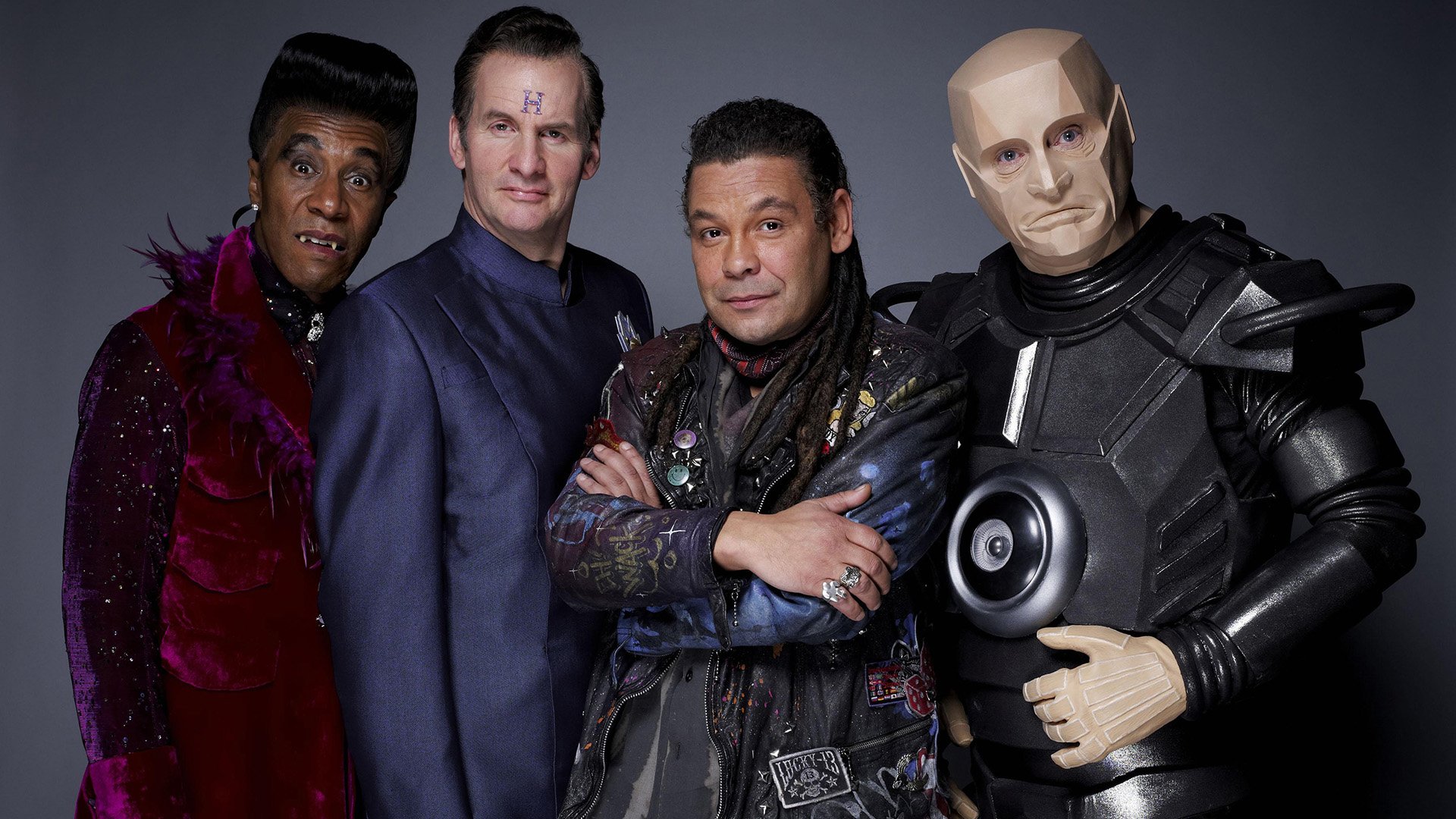Creating culture within science-fiction can be tricky. It’s potentially alienating, with the audience required to understand allusions without a reference point. Then again, if you throw in too many contemporary references, the future starts to look dated pretty quickly. Red Dwarf has walked that fine line, building its own stars and entertainment but chucking in the familiar, just to keep the world grounded. We take a look at humanity’s future culture as seen through the eyes of Lister, Rimmer, Cat, Kryten and Holly.
Music
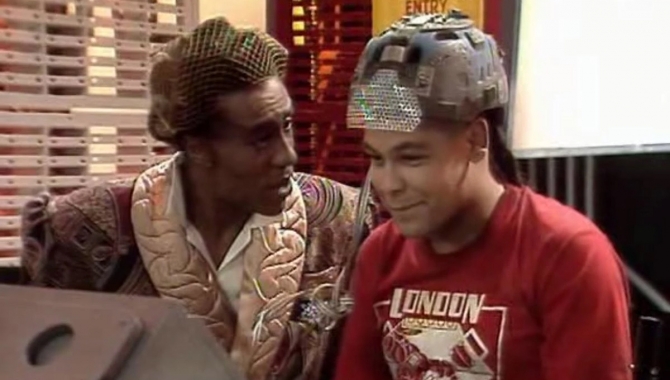

Red Dwarf set out its fictional musical world early on with the opening scenes of the first episode showing Lister irritating Rimmer with variations of ‘Lunar City Seven’, a song detailing a trip around the many moons of the solar system. The music of George and Ira Gershwin has survived with Rimmer showing a fondness for ‘Someone to Watch Over Me’ dreaming it would become the song he shared with his imagined love in Thanks For The Memory. Rimmer also has affection for classical artists including Mozart, Mendelson and Motorhead, which he much prefers to the stylings of Rastabilly Skank, Lister’s favourite artist whom he plays during Balance Of Power. The bunkmates’ musical differences are further highlighted when Rimmer’s heroic parallel universe counterpart turns up in Dimension Jump and joins Lister in a morale-boosting Rastabilly singalong during a difficult repair.
Meanwhile, Rimmer wonders why nobody wants to join him in listening to Reggie Wilson’s Hammond Organ Stylings including the hit albums ‘Pop goes Delius’ and ‘Funking up Wagner’. The next year when in Quarantine Lister, Cat and Kryten were all treated to a delightfully looped version of ‘Reggie’s Tango Treats’, which for some reason, they didn’t enjoy. Rimmer also likes Christian rock with Frank Assisi and the Apostles’ Hymns in Rock revealed to be a particular favourite during Krytie TV. Surprisingly Arnie isn’t into the big band sounds of Glenn Miller, warning the DNA ship that they don’t want to be bored by ‘Pennsylvania 6-5000’ just in case it was planning to return the missing singer. In that episode Kryten, with his new human appendage can’t quite grasp the idea that Perry Como sang ‘Memories are Made of This’ with one of those stashed in his slacks.
Still nothing can quite compete with the Cat’s favourite tune of Robert Hardy reading Tess of the d’Urbervilles warped by a twisted tape in series II’s Queeg.
No show featuring a Scouser can go by without a mention of The Beatles but it was Holly who mentioned the fab four in Parallel Universe giving the example of Ringo being really good as a huge difference in the dimensions. He seemed to enjoy using twentieth-century musicians to help explain complex situations citing Jimmy Osmond as the exception that proves the rule that there’s a logical explanation for everything.
Television
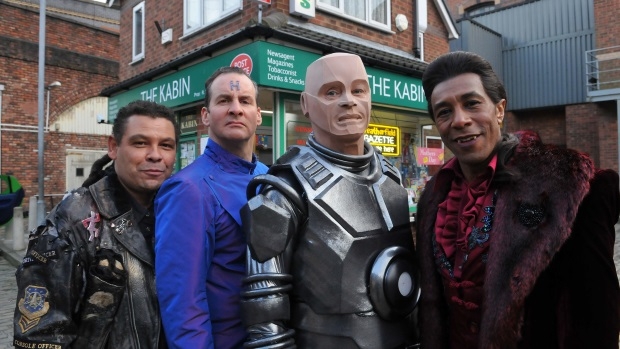

Box sets certainly made it to the future, as Dave Lister boasted in Camille that he had seen all 137 episodes of popular 1980s hospital drama St. Elsewhere. Rimmer also enjoyed a good box set, taking in Victory South a fascinating drama about the American Civil War where the South wins (an idea that’s now controversially gone into pre-production from the Game Of Thrones showrunners). Sadly for Rimmer he was unable to watch the 24 episodes of the second season as he wished to during series X’s Fathers And Suns as predictive computer Pree knew he wouldn’t enjoy them since all his favourite characters were killed off.
Entertainment from the twentieth-century seemed to be fairly commonplace with both Cat and Lister being big fans of The Flintstones declaring Wilma to be the sexiest woman who ever lived during series III episode Backwards. Syndication is still apparently commonplace with Kryten stating in Beyond A Joke that Channel 22 showed Tales Of The Unexpected. Not everything from that era made it to the Dwarfers’ future with the crew completely failing to recognise the distinctive cobbles of Coronation Street while caught up in the events of Back To Earth. The art of the soap opera hasn’t died off though, as in his debut appearance, Kryten’s favourite pastime was seen to be watching Androids, an Australian production directed by Kylie Gwenlyn, a reference to the late Gareth Gwenlan who famously refused to commission Red Dwarf due to its unconventional setting.
The world’s biggest science fiction franchise is also still around, although presumably it’s returned to something closer to Roddenberry’s vision as when Kryten asks ‘Is this the human value you call friendship?’ during The Last Day. Lister retorts, ‘don’t give me that Star Trek crap, it’s too early in the morning.’
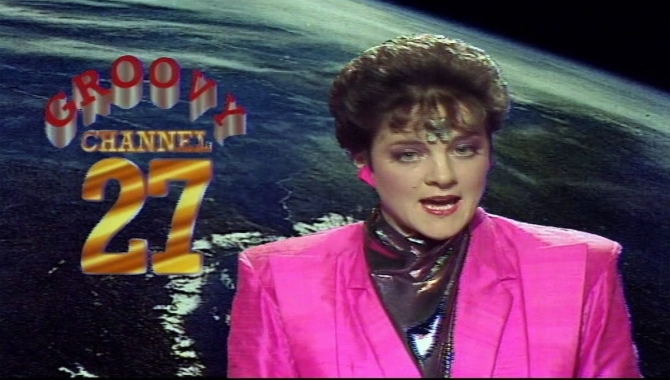
The twenty-fourth-century does have plenty of its own TV. Groovy Channel 27 is considered ground-breaking thanks to its use of a hologram as a newsreader as seen in Series II’s Better Than Life. This is clearly Lister’s favourite source of current affairs, given he also seems to have developed an affinity for the weather girl and the particular way she uses her pointy stick as mentioned in the series VI opener Psirens. This trashy channel is perhaps the home of other entertainment shows of the era including Lifestyles of the Disgustingly Rich and Famous in which Blaize Falconburger discusses… well you can probably guess from the title. Lister’s personal obsession is Mugs Murphy, a cartoon gorilla seen in the cinema in Me2and also features on his t-shirts during the first two series.
Shopping channel satellites are still floating around the galaxy with Lister becoming obsessed with buying a Stirmaster during the events of Trojan. There’s even some home-made trashy TV with a reprogrammed Kryten setting up his own pay-per-view service from prison in series VIII’s Krytie TV which involved both adult action from the women’s showers and “hilarious” Jeremy Beadle-style pranks.
Films
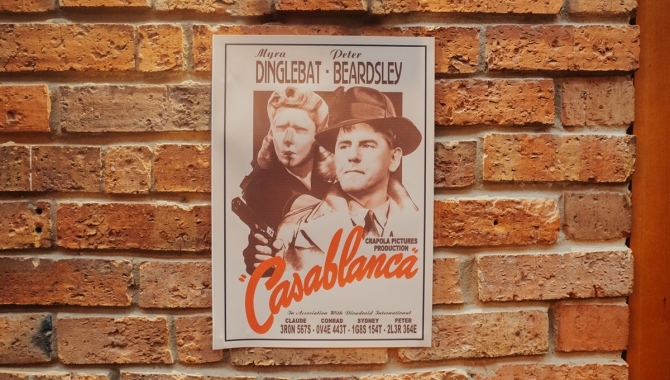

The classics very much remain the classics in Red Dwarf. As part of Kryten’s education to break his programming in his titular first appearance, Lister shows him The Wild Ones and Rebel Without A Cause which was somewhat ruined by the mechanoid’s insistence on fixing Lister’s lapels with his Brush-O-Matic during the rebel speech. Casablanca also plays a huge part in Kryten’s learning as it contains multiple examples of how lying can be noble which comes in handy during the events of Camille. Although Kryten references Humphrey Bogart, it’s a film that’s been remade on many occasions and when the latest version arrives in the post pod in Better Than Life Lister is quick to declare the version starring Myra Dinglebat and Peter Beardsley as definitive. Also in that collection was Friday the 13th Part 1649, so it’s reassuring to know that not everything gets rebooted. There’s more horror found on board the low ship in series V’s Demons And Angels with Revenge of the Mutant Splat Gore Monster and Die Screaming with Sharp Things in your Head being the highlights of the ship’s video collection. While Rimmer may never have read any Shakespeare, he reveals to Lister when they’re marooned that he’s seen West Side Story which he thinks is based on one of his plays. Presumably at least one of the gang has seen Blade Runner given their shared hallucination in Back To Earth uses both the structure and icons of that film, and it even gets a namecheck on the in-universe DVD synopses within the episode.
Literature
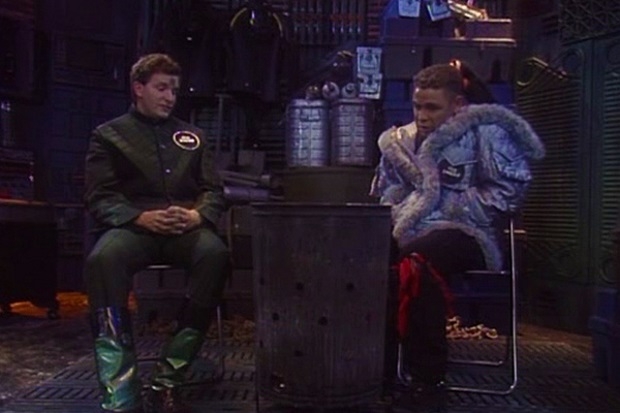

Early in series I, Holly claims to have read every book in existence, concluding that Kevin Keegan’s Football: It’s a Funny Old Game is the worst book ever written. He does have a particular fondness for Agatha Christie though asking Lister to erase them from his memory so he can enjoy them anew. In series VII’s Beyond A Joke, the boys get the opportunity to interact with some classic literature with a trip to Kochanski’s favourite artificial reality program Jane Austen World, spending time in Pride And Prejudice Land although the Cat couldn’t stand the tight trousers of the era. Of course, they were already familiar with a range of classic books with Rimmer’s collection including works by Harold Pinter, Charles Lamb, Herman Wok, Sir Francis Bacon and Eric Van Lustbader but all of them remind the starving Lister of food during Marooned. Although Lister claimed that he’d never read a book, in The Inquisitor he’s seen reading comic book version of Virgil’s The Aeneid (a full six years before 300 reached our shelves) , however, Kryten disapproves of its deviation from the original text with its “Zap, pow, kersplat” dialogue.
Sport and games
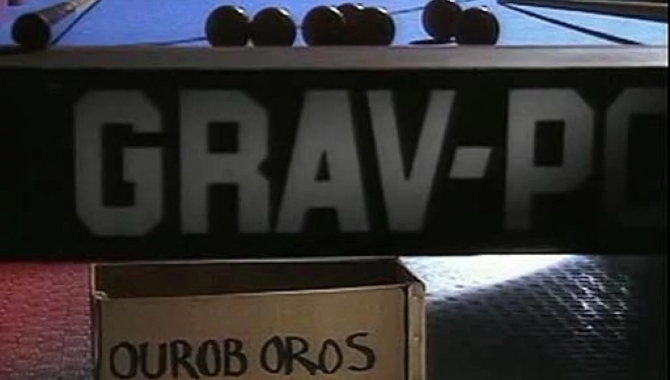

The king of sport, at least in Lister’s eyes, is Jim Bexley Speed, roof attack for the London Jets Zero-G football team. Lister had a photo taken with his idol which has remained on his bunk through every move and he even named his twin sons Jim and Bexley in tribute to the sporting star as seen in Future Echoes. The manager of the London Jets also made an appearance of sorts in the form of with the embodiment of Lister’s confidence taking on his physical form in series I episode Confidence And Paranoia. Lister mentions the unpleasantness playing away to Leeds in both series VII’s ‘Stoke Me a Clipper’ and series XII’s ‘Cured’ and QPR get a namecheck from Holly in Pete – Part 1 with reference to their defence acting as though frozen in time. Presumably these are also now Zero-G teams although Kryten does mention his lying is so good he could work for FIFA in series XI’s Give And Take.
Other sports seemed benefit from a lack of gravity with Lister enjoying Zero-G Kickboxing in the AR suite during Gunmen Of The Apocalypse. It’s also revealed that Lister was found under a Grav-Pool table as seen in series VII’s Ouroboros. That’s not to say that old fashioned sports don’t still exist with Lister and Cat seen enjoying a mostly conventional game of golf when playing Better Than Life.
To kill time, Cat and Lister invented their own versions of popular sports including Durex volleyball, unicycle polo, table golf and tiddlywinks show jumping. Of course, none of them can compare to the thrills and spills of fresh water fishing as offered by the fictional board game Junior Angler as seen in Timeslides. For those looking for a twist on a classic, Mine-opoly gives players a chance to experience the joys of interstellar capitalism with Rimmer revealing in Samsar that he’s never lost a game. He’s also particularly talented at military strategy game Risk, saving memories of his finest games in his campaign diaries.
Holly also reveals that he loves a board games in Queeg, challenging his backup computer to a game of his choosing, offering draughts, poker, Subbuteo, snakes and ladders, Monopoly and Cluedo as alternatives to Queeg’s choice of chess.
Icons
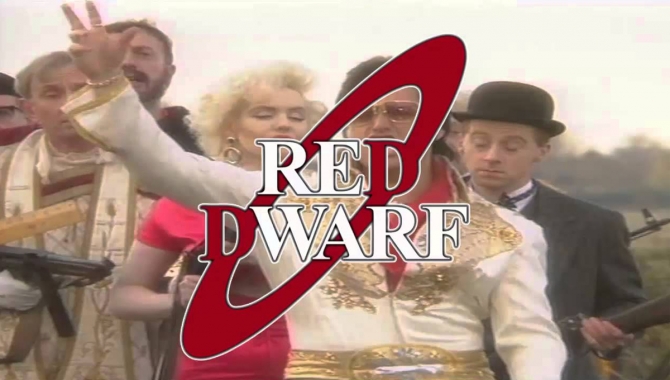

Marilyn Munro’s star continues to shine, appearing in three different episodes in series II, III and IV. She first pops up in series 2 opener Kryten as a poster on Lister’s locker, showing she’s a recognisable part of the world. She then makes an appearance later in the series as a computer sprite in the game Better Than Life. She’d be back the next year in the form of an unconvincing kit droid for The Last Day, and again in series IV as one of the rebellious droids on Wax World. Also present in wax form were Elvis Presley and Winnie the Pooh, whose cruel fate is perhaps best forgotten.
Hitler led the bad guys on that particular waxy adventure and he first made a special guest appearance as himself in series III episode Timeslides, with Lister accidentally preventing his assassination. He would return in the series XII opener Cured as a droid programmed to act like a good version of Hitler, but he didn’t really look that like him. On the other side of the political spectrum, the crew prevent JFK’s assignation before saving his legacy during series VII time travel adventure Tikka To Ride, ensuring that the airport gets named after him.
Most notably, Felicity Kendal’s legend lived on with Holly mentioning they flew around a moon shaped exactly like her bottom. Curiously enough, the remastered version of the show changed this joke, not for reasons of good taste, but to make it more recognisable to international audiences. Predictably, it was Marilyn Munro’s posterior which ended up the butt of the joke in the rewrite.

